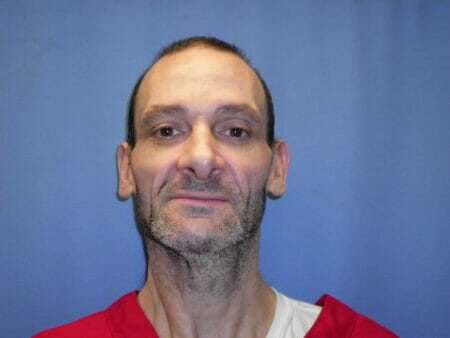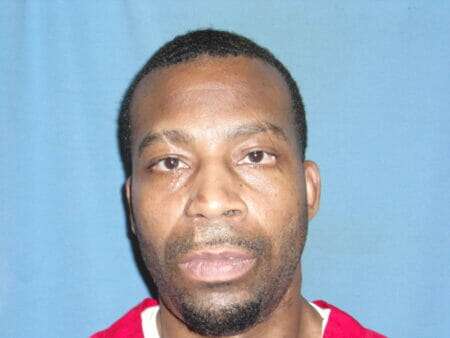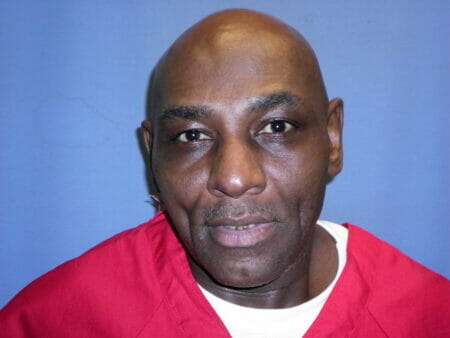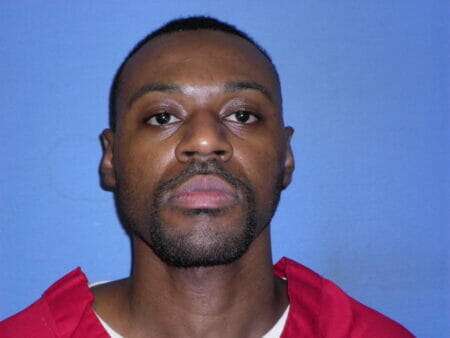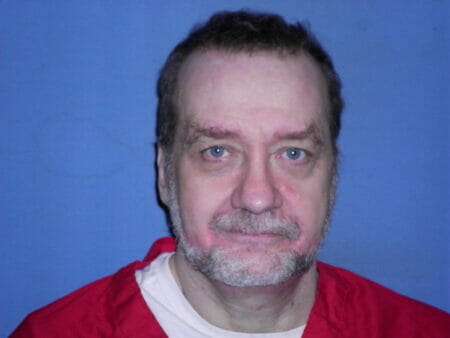
Charles Crawford was sentenced to death by the State of Mississippi for the sexual assault and murder of a college student. According to court documents Charles Crawford kidnapped Kristy Ray from her home, the woman was sexually assaulted, handcuffed to a tree and stabbed to death.
Mississippi Death Row Inmate List
Charles Crawford 2021 Information
| Race: WHITE | Sex: MALE | Date of Birth: 02/10/1966 |
| Height: 6′ 1” | Weight: 230 | Complexion: FAIR |
| Build: MEDIUM | Eye Color: BLUE | Hair Color: BROWN |
| Entry Date: 06/24/1993 | Location: MSP | UNIT: UNIT 29 |
| Location Change Date: 08/03/2017 | Number of Sentences: 6 | Total Length: DEATH |
Charles Crawford More News
On Friday, January 29, 1993, at approximately 12:30 p.m., twenty year old Kristy Ray went to the bank where her mother worked. Kristy worked part-time at the Sunburst Bank, since she was also a student at Northeast Mississippi Community College. At about 5:15 p.m., Kristy and her mother, Mary Ray, left the bank, with plans to see each other later that night at their house in Chalybeate, a community near Walnut, Mississippi.
¶ 5. Mary tried to call Kristy around 6:45 p.m., but received no answer. She assumed that Kristy was visiting her boyfriend. Mary finally got to her house at about 7:00 p.m., but Kristy’s car was not there. When she walked into her house, Mary found a ransom note on a table. The note, which also contained a crude map, read, “There will be a red flag somewhere on this block Tuesday, 12:00 midnight, fifteen thousand dollars in gym bag or she dies. No police.” Mary noticed that Kristy had left her purse, that Kristy’s room was in disarray, and that the phone was dead.
¶ 6. Mary left the house and drove to Walnut, first stopping at the home of Kristy’s boyfriend, Brian Mathis. Not finding her there, she next went to the video rental store where Kristy worked on the weekends; however, no one there had seen Kristy. From the video store, Mary called her husband, Tommy Ray, and then she called 911 to report Kristy’s disappearance to the Tippah County Sheriff’s Department. After conducting preliminary investigations, the Sheriff’s Department contacted the FBI.
¶ 7. Mary returned home, noticing signs of forced entry. She found that a screen over a window in Kristy’s room had been cut out and that a stacking pallet had been left leaning against the house under Kristy’s window. Later Mary discovered that someone had been through one of the drawers in her and her husband’s bedroom.
¶ 8. Also on the day of Kristy’s disappearance, Charles Crawford’s family discovered a ransom note in their attic that was similar to the one found by Mary Ray. Fearing that Crawford, who was due for trial on the following Monday for assault and rape, might kidnap someone, Crawford’s mother, wife, and grandfather reported the note to William Fortier, the attorney representing Crawford on other pending criminal charges. Fortier alerted the law enforcement officials investigating the facts surrounding Kristy’s disappearance. On the following day, Fortier’s law clerk, Shawn Akins, met with law enforcement officials and turned over some medical records; the officials were trying to determine whether Crawford was capable of committing the crime against Kristy.
¶ 9. The local and federal authorities established a command post at the Chalybeate school on the Saturday following Kristy’s disappearance. Additionally, authorities stationed law enforcement officers at the residence of Mr. Miles, Crawford’s former father-in-law. Officers reported seeing Crawford approaching the residence, and Officers Jim Wall and Sammy Pickens of the Mississippi Highway Patrol proceeded to the place where Crawford was seen. At the scene were the sheriff of Tippah County, his deputies, and several FBI agents. When Crawford finally returned to the residence on Saturday, he was arrested, carrying a double-barrel shotgun and a switchblade.
¶ 10. Upon arrest, Crawford was transported by Wall and Pickens. Wall testified that in the car, he asked Crawford if he recognized him, to which Crawford replied yes. Then he advised Crawford of his Miranda rights. After Wall was done, Crawford asked something to the effect of “Why are you asking me this,” or “What is going on here.” Crawford said that he didn’t know Kristy personally, but he knew her when he saw her. Wall testified that in the car, Crawford said that he thought his leg was broken, but that he did not want to go to a hospital.
¶ 11. Originally, Officers Wall and Pickens were directed to take Crawford to the Tippah County Jail in Ripley. They discussed taking Crawford to the hospital. While en route to the jail, they were instructed to bring Crawford back to the command center in Chalybeate. They continued with Crawford to Chalybeate.
¶ 12. Upon arrival at the command center, Officers Wall and Pickens turned Crawford over to Joseph Jackson, the agent in charge of FBI operations in Mississippi. Jackson re-Mirandized Crawford, and proceeded to interview Crawford with Agents Jim Maddock and Tom Bush. Crawford did not sign a waiver of his rights, but he immediately responded to Jackson after being advised of his rights, saying that he could not understand why the officers wanted to talk to him but that he would answer questions. Crawford complained that he had not been doing anything and that his back was injured as a result of falling into a well. During the interrogation, Crawford was allowed to lie prone on the floor, to alleviate any back pain he might have been suffering. Initially, Crawford said that he had been hunting. Jackson asked Crawford if Kristy was alive and Crawford began to cry, admitting that Kristy was no longer alive. When asked, Crawford agreed to lead law enforcement to her body. Jackson testified that the questioning of Crawford took about twenty minutes.
¶ 13. Crawford and law enforcement officials left the command center at about 8:00 on that Saturday night. Crawford escorted law enforcement through extremely rugged terrain and thick woods. Crawford actually led the search team. Crawford never complained about his back during the search. The team reached a heavily wooded area covered with leaves, and Crawford indicated that Kristy was there. When Kristy’s body was found, Crawford asked investigators why they did not finish him off. Kristy was found at approximately 9:48 p.m., approximately four hundred yards from an abandoned barn (the Hopper Barn).
¶ 14. Officer Wall raked the leaves back to uncover Kristy’s body. He found her hands were cuffed behind her back around a small cedar sapling. A sock had been stuffed into her mouth, and a gag was around her head to keep it in place. Kristy had not been blindfolded. Her jeans had been pulled down below her hips.
¶ 15. Dr. Steven Hayne, a pathologist, testified that Kristy had suffered a single stab wound to her chest. Kristy had multiple abrasions over the right and left lower extremities, as well as scrapes to the skin on her back and buttocks. She also had scrapes on her face and chest, as well as contusions on her lips and abrasions on her wrist. The wrist injuries were consistent with Kristy being handcuffed. Hayne testified that the scrapes found on Kristy’s buttocks and thigh occurred while Kristy was alive and were consistent with injuries a person would receive while engaged in a fight or flight response. He also testified that the injuries were consistent with Kristy being dragged along a hard surface, possibly branches or twigs. The injuries were also consistent with those occurring on someone attempting to avoid or resist a rape. The abrasions on Kristy’s face and contusion on her lip were consistent with her face being pressed against a hard surface, as opposed to being dragged. Hayne testified that Kristy died from a large stab wound to the left mid-chest which punctured her heart and left lung, causing extensive internal and external hemorrhaging. It took Kristy between one and two minutes to die.
¶ 16. Hayne testified that the wound that caused Kristy’s death could have been made by a Marine Corps-style Ka-Bar knife. The wound itself measured one and one-quarter inches in width and four and one-half inches in depth, corresponding with that knife. Kristy also suffered “multiple contusions that measured up to approximately one centimeter which would be three-eighths of an inch about the anal orifice,” which suggested penetration of the anus.
¶ 17. On the Monday following his arrest and the location of Kristy’s body, Crawford gave a more detailed account of the kidnaping and murder to the FBI. Agent Newsom Summerlin of the FBI conducted an interview of Crawford at the Union County Sheriff’s Office with Lieutenant Steve Williams of the Mississippi Highway Patrol. Summerlin testified that prior to the interview, Crawford read an interrogation advice or rights form, and signed a waiver of those rights. Summerlin testified that Crawford stated that he did not know Kristy but that he had seen her around the Walnut, Mississippi area. Crawford also stated that he was worried about “an upcoming event” and wanted to be alone, and that when he wanted to be alone, he went to the Hopper Barn. Crawford stated that in the early morning of Friday, January 29, 1993, his mother, Johnny Ruth Smith, dropped him off along Providence Road (near the Hopper Barn) to go hunting. He had an over-and-under double barrel shotgun. Crawford also stated that he had a knife similar to a Marine Corps Ka-Bar knife and a .22 caliber revolver. Crawford said that he had been stockpiling food and drink at the Hopper Barn for approximately one month, so when he got to the barn he had some cookies and a drink.
¶ 18. Crawford said that he was very concerned about his upcoming event, and he had considered running away, but had no money. He also considered suicide, but could not bring himself to do it. He stayed at the barn until midday, when he left to hunt and hike. After reaching an area he was not familiar with, Crawford decided to build a fire, which he soon put out because he was concerned that someone would see the smoke. It was at this point that Crawford claimed to have a blackout; he stated that the next thing he remembered was being inside the Ray residence. Crawford said that when he came out of the blackout, he heard someone crying in one of the back bedrooms of the house. Kristy was on the floor of one of the rooms with her hands cuffed behind her back. Crawford said that he put on a ski mask so that Kristy would not be able to identify him and asked Kristy where the keys to her car were. Crawford stated that he took Kristy and put her in the car and drove away. Crawford stated that he took Kristy from the house because he did not know what he was going to do and figured it was better to take her with him.
¶ 19. Crawford denied writing or ever having seen the ransom note found by Mary Ray. Crawford stated that Kristy was very upset when they left her house that Friday night, but as they drove around and began talking, she began to calm down. He claimed that they drove around for about forty-five minutes to an hour talking to each other. Crawford then abandoned the car and took Kristy out. She was still handcuffed, and he still had the knife, revolver, and shotgun. He claimed that he removed the handcuffs when she promised not to run away. The two of them walked back and forth along Jonesburough Road, and Crawford decided that since it was getting cold, they should go to the Hopper Barn and spend the night there.
¶ 20. Crawford stated that as they approached the barn, he fell into a sinkhole that came up to his neck, tossing his shotgun away as he fell. He claimed that Kristy asked him if he was all right, picked the shotgun up, and helped pull him out. Crawford claimed that he and Kristy had something to drink, ate cookies, and huddled together in the barn for warmth and talked throughout the night.
¶ 21. Crawford said that the next morning, Saturday, he heard a police siren and thought he saw a sheriff’s office car coming away from his grandparents home, which was near the Hopper Barn. He said that he told Kristy it was the law, and she tried to talk him into turning himself in. Crawford then fled into the woods with his shotgun and knife.1 He claimed that Kristy ran after him in order to try and convince him to turn himself in to the authorities. He claimed that Kristy told him no one had been hurt and she would help him if he turned himself in. He was concerned because he did not know how he was going to explain abducting her. Crawford said that he felt low, and Kristy had more or less convinced him to let her go.
¶ 22. Summerlin noted that until this time, Crawford said that he kept the ski mask on at all times except when it was dark inside the barn and Kristy could not see his face. Crawford said that when Kristy convinced him to let her go, he then took his mask off and Kristy allegedly recognized him as someone she had seen around town. Then Crawford stated that as they began walking back to Kristy’s car, he gave Kristy the shotgun. Crawford claimed that at that point he had another blackout.
¶ 23. The next thing Crawford remembered was sitting on a stump in the woods wearing a T-shirt, blue jeans, and no shoes. Kristy was lying at his feet, handcuffed behind her back, dead. He claimed that she was fully clothed with one of his socks in her mouth. He then decided to hide the body and dragged Kristy by her feet across the ground. This is how Crawford explained her pants and underwear being pulled down and her shirt being pulled up. Then he covered her body with leaves, so that no one would find the body. Crawford stated that he sat on the tree stump for a while and thought about what he was going to do. He put his boots back on, retrieved his shotgun and knife and headed back through the woods toward the Providence Road area. Crawford said that he knew people were looking for him, but did not know why. When he neared Providence Road he saw a patrol car, so he sat on the hillside hidden from view. When the patrol car left, he crossed the road into another wooded area. Crawford claimed that he then fell into an abandoned well that was about ten feet deep and had to use his knife to dig himself out.
¶ 24. Crawford continued toward his residence, a house belonging to his ex-father-in-law. As he approached the house, he was arrested. After discussing with Summerlin that he realized that taking Kristy was wrong, Crawford later stated that he originally denied any knowledge of Kristy’s disappearance to buy himself time to think about what he was going to do. Crawford also said that he must have killed her, but could not remember doing so. He told Summerlin that he sometimes had blackouts and could not control himself.
¶ 25. Stephen Thompson of the Mississippi Highway Patrol testified that clothing, bedding, handcuff keys, a padlock with keys, ammunition, food and soft drinks were found in the Hopper Barn. Tim Wilbanks testified that on February 7, 1993, volunteer searchers found a pair of shoes, men’s briefs, long john bottoms, and a T-shirt near where Kristy’s body was found. Wilbanks stated that the shoes, found between trees and shrubs, looked as if they had been thrown there, while the underwear and T-shirt were found under a brush pile. Joe Foster testified that he later found a knife and a pistol in a nylon holster in his field which is located approximately one-quarter mile from the Hopper Barn. Dick Koster of the Walnut Police testified that he searched the area where the knife and gun were found and discovered a belt with a Harley Davidson buckle with the name “Chuck” stamped on the back of it. This belt was similar to one worn by Crawford, whose nickname is “Chuck.” Crawford had previously admitted to investigators that he owned a Marine Corps Ka-Bar knife and a Taurus .22 caliber revolver. The weapons and belt matched the descriptions Crawford gave investigators of the ones he had on the day of Kristy’s disappearance.
¶ 26. Joe Andrews, of the Mississippi Crime Lab, testified that hairs collected from the clothing found in the Hopper Barn were compared with known samples of hair from Kristy Ray and found to exhibit the same characteristics. Andrews also testified that hairs found on clothing recovered by Wilbanks exhibited the same microscopic characteristics as pubic hairs taken from Crawford. Debbie Haller, a forensic serologist with the Mississippi Crime Lab, testified that stains found on the briefs appeared to be a mixture of blood and seminal fluid. The long johns also contained blood stains. The crime lab could not determine the blood group type from these stains. Heller forwarded samples from the briefs and long john bottoms to Cellmark Diagnostic Laboratories to conduct DNA testing, along with known blood samples from Kristy Ray. A vaginal swab taken from Kristy’s body determined the presence of seminal fluid. Heller determined that Crawford could be included as a possible source of the seminal fluid.
¶ 27. Cellmark Laboratories conducted DNA testing of the stains found on this evidence. Julie Ann Cooper of Cellmark testified that DNA evidence extracted from the vaginal swab matched the known DNA samples of Crawford. The mix of blood and semen found on the briefs was matched to Kristy and Crawford. The bloodstain on the long johns also matched both Kristy and Crawford.
¶ 28. Crawford presented an insanity defense through the testimony of family members and Dr. Stanley Russel, a psychiatrist with the Mississippi Department of Corrections. Russel treated Crawford during the time he was housed at Parchman, from June of 1993. Russel testified that Crawford suffered from depression and periods of time lapse about which he has no memory. Russel diagnosed Crawford as a psychogenic amnesiac. Russel referred to the prior medical history of Crawford, including medication prescribed by a psychiatrist when Crawford was ten, his hospitalization in East Mississippi State Hospital in 1989, his hospitalization at a psychiatric facility in Memphis in 1991 and two forensic evaluations at Whitfield. Crawford had been diagnosed with bipolar disorder (manic depressive illness) in 1989, and he had been prescribed lithium, which seemed to calm the moods of manic people. Russel also testified regarding Crawford’s anger and resentment as a child and his antisocial behavior as a teenager. Russel ultimately testified that in his opinion Crawford satisfied “the M’Naghten test for not being criminally responsible for his actions as a result of mental disorder that affected his reasoning to the point that he was not aware of the nature and consequence of his behavior.”
¶ 29. Rebuttal testimony was presented by Dr. Chris Lott, a clinical psychologist with the Mississippi State Hospital. Lott testified that he saw no evidence that Crawford ever suffered from bipolar illness, based on his review of the diagnosis at the East Mississippi State Hospital. Lott did not think that Crawford had a disease of the mind, an illness, or major mental disorder. He testified that there was nothing in Crawford’s records to show that he was delusional or that he was suffering from irrational belief or hearing voices. He also testified that Russel improperly diagnosed Crawford as a psychogenic amnesiac because Crawford “appeared to be malingering his problems or memory deficits.” Lott stated that Crawford showed premeditation and that he knew the nature and the quality of his actions and that he was able to distinguish between right and wrong.
¶ 30. Dr. Reb McMichael, a forensic psychiatrist with the Mississippi State Hospital, testified that Crawford did not meet the requirements of M’Naghten at the time of the crime. McMichael stated that psychogenic amnesia was a rare diagnosis and that in his opinion, Crawford did not have it. McMichael believed that Crawford was planning an act and purposely concealed Kristy Ray’s body and that this showed that he knew the nature and quality of his act-that the act was wrong and that he did not want to get caught.2


